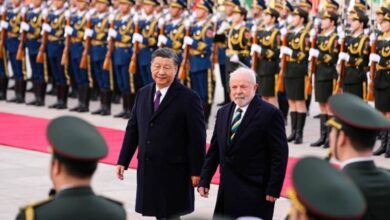Colombia’s Fighter Acquisition in Flux as China Pushes J-10CE Bid

A late-spring thunderstorm rolled over Beijing just as Colombia’s Gustavo Petro received a confidential folder from Xi Jinping—an audacious Chinese bid to equip the Fuerza Aeroespacial Colombiana (FAC) with J-10CE fighters. The document could yank Bogotá onto an entirely new geopolitical runway.
A Shock Wave from Beijing
Few Colombian officials expected fireworks on Petro’s May 2025 state visit; the Gripen deal with Sweden already looked signed and sealed. Then, Chinese aides produced a glossy prospectus: up to twenty-four Chengdu J-10CE multirole jets, a complete missile suite, and the first deliveries within twenty-four months. Base price? According to figures published by Global Defense News, about $40 million per airframe, with generous sovereign financing and training thrown in.
Petro’s entourage, still drying rainwater from their jackets, felt the ground shift. Colombia had leaned on Western suppliers for two generations—Israeli Kfirs, American helicopters, and Spanish transports. Now, Beijing dangled a path free of U.S. end-user strings or export-license vetoes. By nightfall, the president had phoned Bogotá, instructing top brass to “study the dragon’s offer in cold blood.”
Inside the FAC headquarters, colonels reopened spreadsheets they thought were settled. One logistics officer quipped, “It’s like ordering a Swedish sedan, and the dealer suddenly offers a Chinese sports car at half price—plus fuel vouchers for a decade.”
Battle Tales from the Subcontinent
China’s sales pitch leaned heavily on combat lore. Global Defense News reports that Pakistani J-10CEs allegedly scored kills against Indian Rafales, Mirages, and Sukhois during a 2025 flare-up. New Delhi disputes every claim, yet the narrative fascinates Colombian pilots who crave proof a fighter can survive real missiles, not just mock dogfights.
Beijing’s envoys highlighted the jet’s AESA radar, PL-15 long-range missiles, and infrared search-and-track—plus the promise of round-the-clock parts support straight from Chengdu. They even produced cockpit audio of Pakistani pilots celebrating “Fox-3” launches, though the tape’s authenticity remains unverified.
Skeptics in the Colombian Senate demanded hard evidence, not fog-of-war headlines. Still, the idea of fielding an aircraft battle-tested against modern French and Russian machines lit up WhatsApp groups among FAC squadron leaders. One veteran, speaking privately, admitted, “Whether the shoot-downs happened exactly as claimed almost doesn’t matter; the J-10 now carries an aura of having been blooded.”

Ministry of National Defense of Colombia
Gripen, Uncle Sam—and the Shadows of Dependence
The sudden Chinese courtship lands while Bogotá is inches from a contract with Saab. Sweden’s Gripen E/F comes with offsets in renewable energy, water infrastructure, and an eight-year loan grace period—a tidy package for a government chasing green-growth headlines. Brazil already flies the same jet, offering shared training across the Amazon corridor.
However, detractors point to one vulnerable artery: the U.S.-built General Electric F414 engine. Should Washington sour on Petro’s foreign policy, spares could dry up overnight. Memories of grounded Kfirs, when Israel throttled parts during export-control tussles, still sting.
China seizes on that fear. Its pitch stresses “no third-party permissions, ever.” Parts, software keys, and even munitions lie solely in Beijing’s hands. Paradoxically, dealing with a single-source manufacturer can feel safer than juggling American politics.
Meanwhile, Washington refuses to stay silent. U.S. diplomats push a counter-offer for F-16 Block 70/72 jets, sweetened with refurbished Air Force frames at fire-sale prices. Behind closed doors, trade concessions on coffee and cut flowers surface in the same breath. Colombia’s defense minister recently joked that his briefcase now smells like a Starbucks blend.
A Decision That Echoes Beyond the Andes
As June 2025 ends, the choice sits on Petro’s desk. Option A: sign the Gripen contract, cementing ties with Sweden, Brazil, and NATO-interoperable kit. Option B: pivot to China, shocking Washington but gaining budget relief and political autonomy.
Either way, the clock ticks. Colombia retired its last 22 Kfirs in 2023; pilots log simulator hours while alert squadrons borrow transport planes for air-policing drills. “We need wings, not white papers,” one commander grumbles.
Economists run parallel ledgers. The headline purchase is significant, yet life-cycle costs—fuel flows, hangar refits, data-link upgrades—might tilt favor toward the Gripen, whose road map dovetails with regional supply chains. Conversely, Beijing offers low-interest yuan loans and hints at highway and port investments if Bogotá becomes the first Latin American J-10 customer.
Diplomats weigh softer variables: a Chinese buy could fracture decades-old intelligence sharing with the U.S. Southern Command; a Swedish buy might expose Colombia if future sanctions target American engine parts. Each path bears unknown storm clouds.
Across Latin America, defense planners watch keenly. Peru, Chile, and even Argentina—long starved of modern jets—wonder if Colombia will blaze a new procurement trail. Beijing has courted Egypt, Indonesia, and Morocco with the J-10CE, Global Defense News notes, but none have inked contracts. Colombia could become China’s showroom victory—or a cautionary tale.
Petro has promised clarity before the fiscal-year budget is locked in September. Until then, Bogotá thrives on rumor: one day, cabinet insiders say the Gripen is safe; the next, whispers claim Chinese technicians have toured Palanquero Air Base measuring hangar doors.
For the pilots, the suspense is visceral. In a humid, ready room, a captain taps the photo of a Kfir taped to his locker. “Whichever machine we get,” he says, “I just hope my daughter sees it flying before she finishes grade school.”
Also Read: Latin America’s Cocaine Battle May Get Tiny Flies Reinforcement
The sky over Colombia will soon roar again—either with the throaty growl of a Swedish GE turbine or the sharper bark of a Chinese WS-10. When that first pair streaks above the Andes, the world will know which flag flutters beside Colombia’s tricolor on the tail. And at that moment, Bogotá’s strategic compass—carefully calibrated since the Cold War—will point unmistakably toward its next era, for better or for turbulence ahead.




